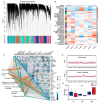Integrated Metabolomics and Transcriptomics Analyses Reveal the Metabolic Differences and Molecular Basis of Nutritional Quality in Landraces and Cultivated Rice
- PMID: 35629888
- PMCID: PMC9142891
- DOI: 10.3390/metabo12050384
Integrated Metabolomics and Transcriptomics Analyses Reveal the Metabolic Differences and Molecular Basis of Nutritional Quality in Landraces and Cultivated Rice
Abstract
Rice (Oryza sativa L.) is one of the most globally important crops, nutritionally and economically. Therefore, analyzing the genetic basis of its nutritional quality is a paramount prerequisite for cultivating new varieties with increased nutritional health. To systematically compare the nutritional quality differences between landraces and cultivated rice, and to mine key genes that determine the specific nutritional traits of landraces, a seed metabolome database of 985 nutritional metabolites covering amino acids, flavonoids, anthocyanins, and vitamins by a widely targeted metabolomic approach with 114 rice varieties (35 landraces and 79 cultivars) was established. To further reveal the molecular mechanism of the metabolic differences in landrace and cultivated rice seeds, four cultivars and six landrace seeds were selected for transcriptome and metabolome analysis during germination, respectively. The integrated analysis compared the metabolic profiles and transcriptomes of different types of rice, identifying 358 differentially accumulated metabolites (DAMs) and 1982 differentially expressed genes (DEGs), establishing a metabolite-gene correlation network. A PCA revealed anthocyanins, flavonoids, and lipids as the central differential nutritional metabolites between landraces and cultivated rice. The metabolite-gene correlation network was used to screen out 20 candidate genes postulated to be involved in the structural modification of anthocyanins. Five glycosyltransferases were verified to catalyze the glycosylation of anthocyanins by in vitro enzyme activity experiments. At the same time, the different mechanisms of the anthocyanin synthesis pathway and structural diversity in landrace and cultivated rice were systematically analyzed, providing new insights for the improvement and utilization of the nutritional quality of rice landrace varieties.
Keywords: UDP-glucosyltransferase; anthocyanins; landrace; metabolome; rice (Oryza sativa L.); transcriptome.
Conflict of interest statement
The authors declare no conflict of interest.
Figures






References
Grants and funding
LinkOut - more resources
Full Text Sources

